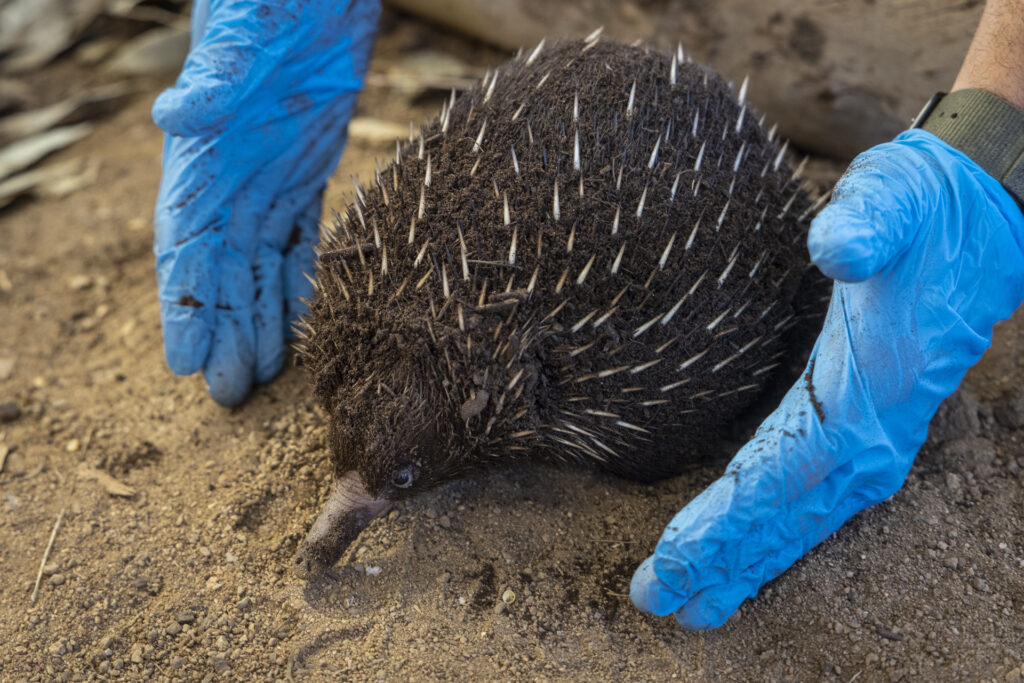
The adorable little ball of cuteness at the top of this page is a baby echidna, also known as a puggle. Like the platypus, echidnas are monotremes—a small group of unusual, egg-laying mammals.
We confirmed breeding behavior in the echidnas in our care via remote video footage. We weren’t able to confirm pregnancy, but based on the behavior of our two females—named Pink and Orange—we were hopeful.
Behind the Scenes
For the first couple of months after a successful mating, here’s what we couldn’t see:
Between mating and egg-laying, a female echidna develops a pouch. About three weeks after mating, she seeks out a shelter and lays a single, grape-size egg. After somehow managing to nudge the leathery egg into her pouch(!), she stays in the shelter for 10 to 11 days, until the egg hatches.
A tiny, fetus-like echidna hatchling still has a lot of developing to do. Its eyes are undeveloped, and its unpigmented, hairless skin is semi-translucent. For the first four days, its lungs aren't developed enough to breathe, and it respires through its skin. For the next two months or so, it continues its development, snuggled up safe and warm in its mother’s pouch. Like other mammals, mother echidnas produce milk for their young. But unlike other mammals, monotremes don’t have nipples or teats; a puggle sucks or laps milk from its mother’s fur near two “milk patches” in her pouch.
Pink’s Puggle
It's difficult to confirm that there is a puggle in an echidna’s pouch, but finally, we saw—via remote camera—a puggle foot hanging out of Pink’s pouch! At this point, we estimated the puggle was about 55 days old. Without an official name yet, the wildlife care team began to refer to this puggle affectionately as “PJ” (for “Pink Junior”).
Pink behaved exactly as her counterparts in their native Australia do. When PJ grew too big to carry in her pouch (at about two months old), Pink deposited it in a nursery burrow. From that point forward, she returned to feed PJ every three to five days. To keep the little puggle warm while she was away, she back-filled the tunnel opening with dirt after each visit, to help stabilize the burrow temperature. (In their native habitat, this also helps keep predators out.) Once Pink started leaving PJ in a nursery burrow, we were able to finally see it with our own eyes. It was about 65 days old.
After about 100 days, young echidnas have developed thick fur and are better able to maintain body temperature on their own. When the puggle was about four months old, Pink broke down the barrier for the last time, and PJ began to explore its new world. It is starting to eat the adult echidna diet, but it still occasionally spends time with mom in the nest box; and we suspect that during those visits, PJ is still nursing.
An Orange Puggle
Remarkably, we observed similar behavior with our other female puggle, named Orange. We first saw Orange's puggle on May 16, when it was about 66 days old. Although it was yet to be named, our team quickly took to calling this puggle “OJ” (for “Orange Junior”). OJ just started to explore its world outside of the nursery burrow in mid-September. We expect it to continue to nurse for a while, and estimate that it will start to show interest in the adult diet within the next couple of months.

Puggle Population
My favorite thing about the puggles is watching how quickly they grow and change. The difference in the puggles from when mom first deposited them into the nursery burrow to when they emerged and started exploring on their own has been amazing! Once these curious, young echidnas start wandering around, it's so much fun to watch them as they investigate everything.
San Diego Zoo Wildlife Alliance participates in the Association of Zoos and Aquariums’ (AZA) Species Survival Plan (SSP) for short-beaked echidnas. Through the SSP, AZA manages the population of about 30 short-beaked echidnas in zoological institutions across the US. While it is somewhat uncommon for puggles to hatch in zoos, this year has been incredible for short-beaked echidna propagation. In addition to the two puggles successfully weaned at the Safari Park, the Brookfield Zoo and Busch Gardens Tampa Bay were each successful in hatching an echidna this year.
We currently have five male echidnas, two females, and two puggles in our care. We don’t yet know the sex of the puggles. Another fascinating thing about echidnas is that they have no external genitalia—and a female develops a pouch only when she is going to have a puggle (insert mind-blown emoji here!).
Jennifer Lebeau is a wildlife care specialist at the San Diego Zoo Safari Park.




